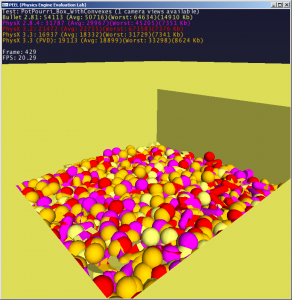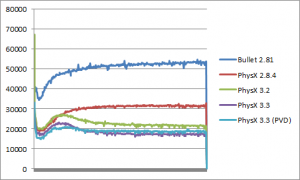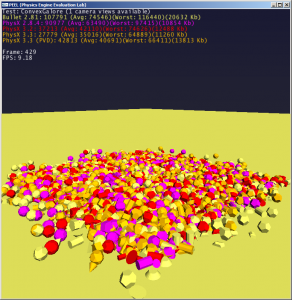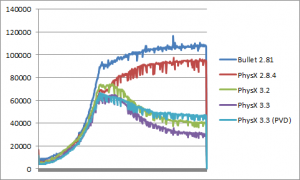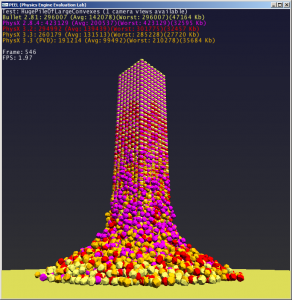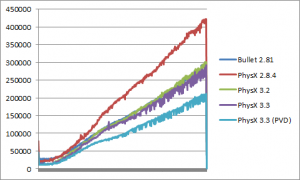The evolution of PhysX (4/12) - Rigid bodies (piles)
Stacks are fun, but games mainly need piles. For example piles of falling debris when you shoot things up. What you usually look for is an engine that can simulate piles without jittering, or wobbling objects. Fortunately all the engines involved here do a good job in that respect, and we can just look at the performance side of things.
—-
The first scene (“PotPourri_Box_WithConvexes”) is a simple box container filled with boxes, spheres, capsules and convexes.
Each PhysX version is faster than the one before. Checked. PhysX 3.3 is about 2X faster than PhysX 2.8.4.
PCM does not seem to help much in this case. And in fact Bullet is significantly slower than all PhysX versions here.
Also, for some reason Bullet is now the one consuming about 2X more memory than the others – while it was quite good memory-wise before. Curious.
—-
The second scene (“ConvexGalore”) is a pile of falling convexes, of various shapes and complexities.
The profile curves were kind of flat so far but this is now changing. The initial part of the curves, while the objects are falling down without touching each other, look remarkably similar in all engines. But then things diverge and 2 trends emerge: for some engines (Bullet, 2.8.4) the curve keeps growing (i.e. performance becomes worse and worse), while for other engines (PhysX 3.x) the curve goes down and performance increases.
Overall each PhysX version is faster than the previous one. Checked.
PCM in 3.3 is ultimately slower than regular contact generation in this case.
Again, Bullet seems to suffer both in terms of performance and memory usage.
—-
The third scene (“HugePileOfLargeConvexes”) is a stress test containing more than 5000 large convexes falling on each other.
As usual, each PhysX version is faster than the previous one. Checked.
The graph shows 3 clear things:
- 2.8.4 is significantly slower than the others
- 3.3 / PCM is significantly faster than the others
- The remaining engines are otherwise very close to each-other, performance-wise.
Since we are using large convexes, it is expected that PCM works better than SAT here. With so many objects falling vertically, other subsystems like the broadphase might have a stronger impact on performance than in the other scenes.
In any case, no big surprise in this one.
